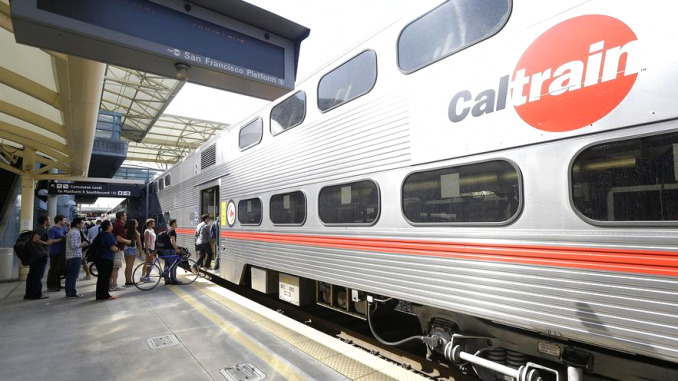
Feb. 13, 2023
By Elaine Goodman
Daily Post Correspondent
Caltrain has regained some of the ridership lost during the Covid-19 pandemic, but the commuter rail line’s recovery is lagging behind that of other Bay Area transit agencies, recent data show.
As of October, Caltrain ridership was at 26% of pre-pandemic levels seen in February 2020. In comparison, BART was at 33% of pre-pandemic rid-ership as of October. Muni, the bus and light rail service in San Francisco, was at 55%.
And ridership on the San Francisco Bay ferry service run by WETA was back to 63% of February 2020 levels.
The data were included in an informational report for the Caltrain board’s Feb. 2 meeting.
“Caltrain ridership (is) on a positive trajectory, but overall recovery continues to lag behind peer agencies and other modes of transit,” the agency said in a presentation.
In other findings, Caltrain’s average weekday ridership was 12,513 in December, compared to 9,687 in December 2021 – a 29% increase. But that was still far short of December 2019, when average weekday ridership was roughly 62,000.
The ridership figures reflect the number of Caltrain boardings, and someone riding roundtrip would be counted once when they depart for a destination and again when they return.
The struggle to regain ridership comes as Caltrain is in the midst of a $2.3 billion electrification project that’s expected to be finished in fall 2024.
To facilitate construction, the transit agency is eliminating train service between Millbrae and San Francisco during four weekends in February and March – a move that may further hurt ridership. Cal-train will provide limited bus service for riders in the impacted area.
Caltrain has taken steps to boost ridership. The agency decided to postpone previously approved fare increases. And Caltrain is offering low-income riders half off their fare through the Clipper START program.
Ridership has also been helped by events, as passengers climb aboard to see the Sharks or 49ers play, or head into the city for concerts or New Year’s celebrations.
Caltrain formed a task force last year to look for other strategies to increase ridership. The idea is to keep existing passengers, attract new ones and convince previous riders to return.
Caltrain is talking to transit agencies in other areas, including Chicago, Philadelphia, Seattle, Southern California, and Northern Virginia, to find out what they’re doing to grow ridership.
There will also be surveys of Peninsula residents to see how much they know about Caltrain, whether they’re commuting to work and what obstacles they face to riding the train.
Even before the pandemic, Caltrain was starting to lose riders.
Daily midweek boardings in 2019 fell to 63,597, a 2.3% decrease compared to 2018, according to passenger headcounts. At the time, officials attributed the decline to trains getting too crowded and the elimination of some shuttle routes due to driver shortages. The shuttles take passengers from Caltrain stations to destinations such as business parks or medical centers.

I find it troubling that we taxpayers are spending billions on improving CalTrain and people aren’t using it. 6,000 riders a day doesn’t justify a 2,3 billion expenditure. Now if each rider were to put up an even share ($383,099 a piece), then I’d be for electrification.
I find it troubling that we’re still spending billions on Caltrans, that we’re still being told that people don’t want cars so developers don’t have to provide parking in their increasingly dense housing complexes and that they still keep building housing in the CalTrain parking lots so people who DID want to take the train can’t.
I love Caltrain but it simply doesn’t run often enough, especially on the weekend (once an hour). I’m eagerly awaiting electrification so that service can increase, which would make it much more viable to use so that I don’t need to plan my whole day around the train schedule.
Bingo, many agencies have made service cuts during the pandemic, and many just offer infrequent and/or unreliable services, which are inconvenient to use, unlike in nations with “first world” high frequency transit services. The electrification project has created some disruptions. Many of these transit agencies have massively cut back on any effective on-board security, with worsening perceptions of unsafe and/or unsanitary conditions on trains and buses, and this has also resulted in a loss of ridership.
The issue with Caltrain is that public transportation is not good enough near my destinations once I get off the train. If there was a good bus system, Caltrain ridership would skyrocket.
Quit complaining about Caltrain ridership! I like having an entire train car to myself!
We’re held hostage by a poorly run agency. If Caltrain were to shut down and all those passengers were to drive instead, traffic would be a nightmare! Keep fares low, make service reliable, and improve bus services from the stations to make it appealing for people to use.
“If Caltrain were to shut down and all those passengers were to drive instead, traffic would be a nightmare!”
Really? Do the math. Ridership now is about one-fourth of what it was before the pandemic. So three-quarters of those who would have normally taken Caltrain are getting to work another way.
Do we have the “traffic nightmares” you’re complaining about?
Nope.
So why do we need Caltrain?